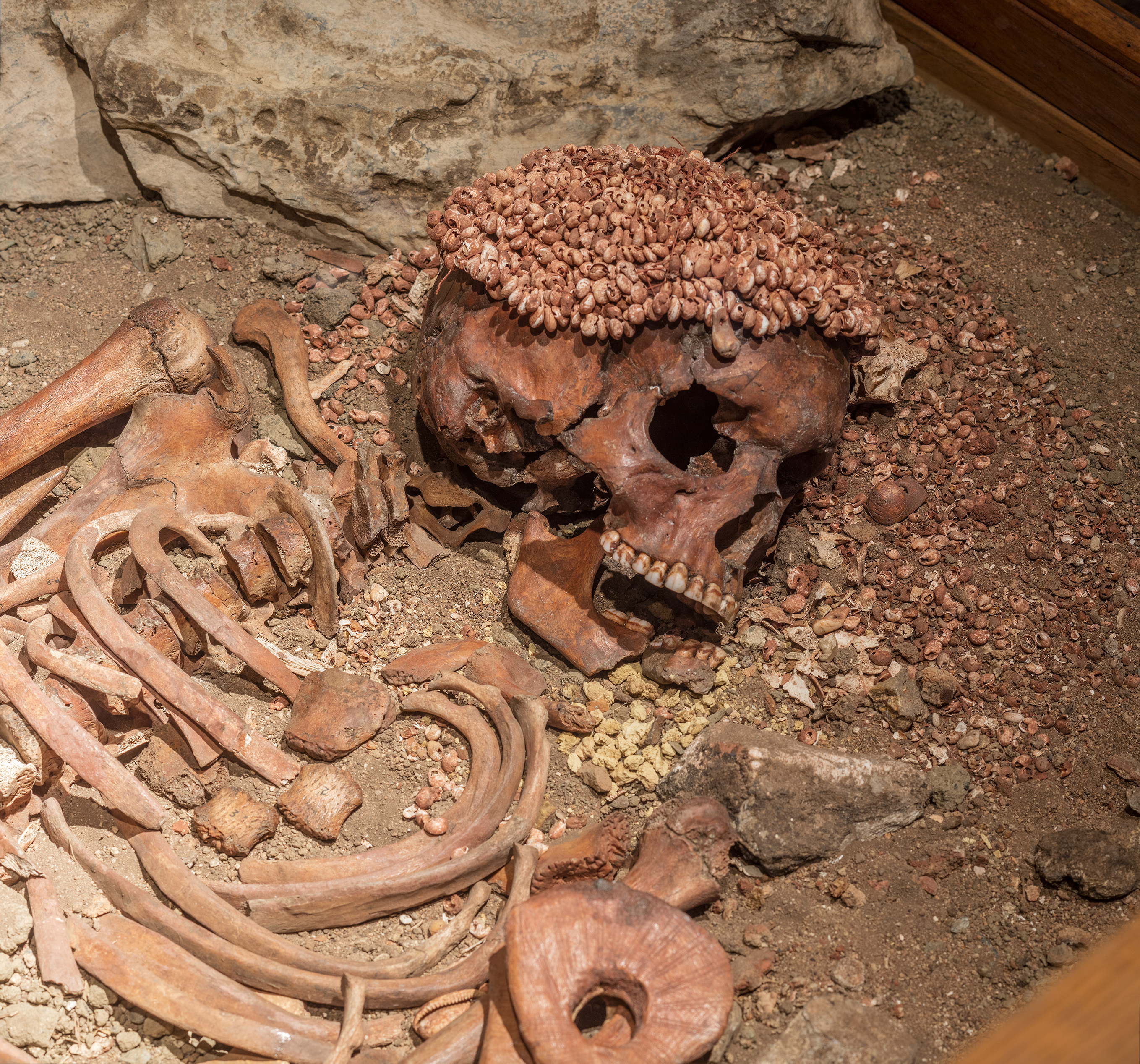
Click here to view image
Burial of the ‘Prince’ of Arene Candide
1954
periodo paleolitico superiore
Upper Paleolithic
Paleolithic - 100.000 BCE - 10.000 BCE
Unità di misura: cm; Altezza: 180; Larghezza: 50
osso
It is one of the most spectacular Upper Palaeolithic burial artefacts, and due to the richness and variety of its grave goods, its excellent state of preservation and its precise stratigraphic location, it has been an important source of archaeological, palethnological and anthropological data since the time of its discovery. Attributed over the course of time by some scholars to the Ancient Epigravettian and by others to the Gravettian, the 'Prince' burial now appears to be definitively classifiable within the latter phase, as proposed by Cardini and also confirmed by direct AMS dating, which qualifies the burial as one of the last manifestations of the rich and elaborate funerary complex that Gravettian culture developed from the 27th millennium onwards. As in the burial of the 'Prince', in other Gravettian culture burials, such as that of Sungir in Russia, the communities to which the deceased belonged felt the need to emphasise signs and gestures in order to elaborate and ritualise violent deaths, extraordinary events and situations. Many individuals from this period, in fact, show skeletal pathologies and are arranged in multiple burials with objects that are exceptional for their material, workmanship, provenance or all these characteristics. In the case of the 'Prince', the devastating wound to the left shoulder was in fact immediately identified by Luigi Cardini as the probable cause of death, a violent death perhaps due to a very strong blow inflicted on the jaw and left shoulder probably by an animal, perhaps a bear or a lion. In any case, the spectacular nature of the burial, which has led scholars to speak of 'staging', indicates that the group of hunter-gatherers to which he belonged must have considered him to be a special individual to whom special funerary treatment was reserved. Some elements of the 'Prince's' trousseau have provided very interesting data. The ivory pendants found on the side of the knee come from the working of the same fragment and represent highly singular objects in Upper Palaeolithic Italian contexts, given the rarity of mammoths in the faunal record of the time. The ivory from which they were made is probably imported material from a long distance, as is the flint of the blade held by the 'Prince', which came from southern France (Vaucluse region) over 200 km away. This is the same flint as the blade found in the triple burial of the Barma Grande, Balzi Rossi, IM, which further unifies these extraordinary funerary events. Recent biomechanical studies would confirm these indications of the mobility of Gravettian populations, a very intense mobility as confirmed by the structural adaptations of certain bones to mechanical stress. These studies have also made it possible to specify that in addition to the shoulder wound, another possible injury involves the fibula of the right leg. The skeleton of the 'Prince' has always been an important source of information on the physical anthropology of the Upper Palaeolithic populations. Initially, studies focused on the skull for a typological classification and to assess its relationship with the Balzi Rossi individuals. approximately, a value in line with those of Gravettian populations and also attributed to the quality of the diet with a good protein component. For the 'Prince' in particular, the stable isotope assay suggests dietary information: around 1/4 of the protein in the youngster's diet in the last year of life was of marine origin. The set of data recently obtained complements the more traditional archaeological and palaeoanthropological data and makes it possible to delineate ever more precisely aspects of the culture and behaviour of the young 'Prince' within the peoples of his time, who have very suggestively been called the 'hunters of the Golden Age' to emphasise not only the variety of animal species to which these populations had access, but also the richness of the archaeological evidence they left us and the complexity of the artistic and funerary manifestations that Gravettian culture was able to express throughout the European continent, from England to Italy, from Portugal to Russia. A burial lying in a bed of red ochre that over time has impregnated the bones and grave goods with colour; ochre was used in Palaeolithic burial rituals to sprinkle the deceased and the burial pit. The individual was buried supine with a few stones over his hands and feet (not visible today) according to a ritual repeated in various other burials of the period. In the burial there is a rich trousseau that determined the modern name of Prince for the individual laid to rest. The trousseau consists of: two ivory pendants in the shape of a figure eight; a charm bracelet consisting of small pierced shells and a pierced pendant of mammouth ivory; a flint blade; four pierced sticks made from elk antlers; hundreds of perforated shells (Nasse) around the head, which allowed the excavator Luigi Cardini to hypothesise the reconstruction, together with two deer canines, an ivory pendant and a Cyprea shell, of a kind of headdress; a lump of yellow ochre in the area of the jaw, as if to fill in the large lack thereof.




